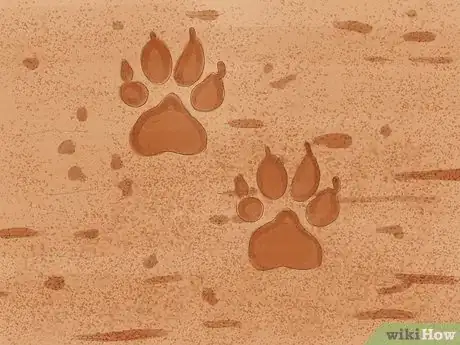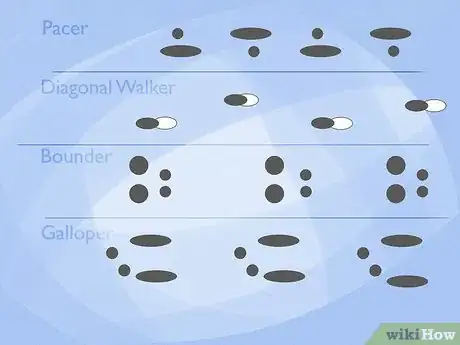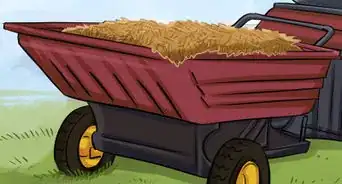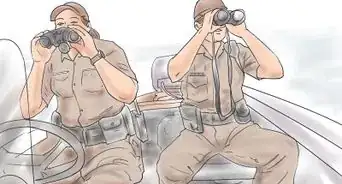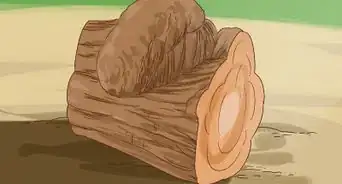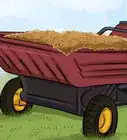wikiHow is a “wiki,” similar to Wikipedia, which means that many of our articles are co-written by multiple authors. To create this article, 20 people, some anonymous, worked to edit and improve it over time.
wikiHow marks an article as reader-approved once it receives enough positive feedback. In this case, 89% of readers who voted found the article helpful, earning it our reader-approved status.
This article has been viewed 92,223 times.
Learn more...
Tracking animals is the art of interpreting signs like footprints, natural paths and nibbled plants to discover who has recently been foraging, hunting or resting in a certain area. Animal tracking is a useful skill to know if you want to hunt or photograph animals, or if you're simply interested in learning more about the creatures with whom you share a habitat. If you want to know how to track bears, birds, rabbits, deer, mice, foxes and more, see Step 1.
Steps
Identifying Animals
-
1Examine a footprint. It's exciting to discover a footprint in the mud or snow, a tell-tale sign that another creature has recently crossed the same path you're taking. Every animal has a distinct print, and if you know what to look for, you'll be able to tell what type of animal might be nearby. When you look at a footprint, pay attention to these factors:[1]
- The size of the print. Right off the bat, you should be able to tell whether the print was likely left by a fox, bear, cat or mouse by the size of the print.
- The number of toes. This is a basic feature of footprints that can be very revealing, since different animals have different numbers of toes in their prints. For example, felines like bobcats and cougars have 4 toes on each foot, while weasels and skunks have five.
- Whether or not nail prints are visible. Feline prints don't show the nails, but prints left by wolves, raccoons and bears show long claw marks.
- Whether the print shows an opposable toe (or thumb). Creatures that can climb trees, like raccoons and opossums, have an opposable digit that enables them to grip the tree as they climb.
- Whether the front and back prints are the same size. Dogs, cats, foxes, bears and many other creatures have front and back feet that are exactly the same size. If you see prints that show tiny front feet and large back feet, they were probably left by a rabbit or hare.
- Whether the prints were left by a hoofed animal. The print of a deer, moose, elk or another hoofed animals is quite distinct from that left by an animal with paws.
-
2Examine the track pattern. The next step is to look at where the footprints fall and try to identify a pattern. You can determine an animal's gait by interpreting the track pattern. Since different animal families have different gaits, examining the track pattern can help you figure out what type of animal tracks you're seeing. You can also use the track pattern to predict where the animal may have gone. Here are the most common track patterns:
- Diagonal walker pattern. Diagonal walkers, including felines, canines, and hoofed animals, lift the front and hind legs on opposite sides at the same time. They leave behind staggered tracks. Imagine the way a horse walks or trots and the prints he leaves behind.
- Pacer pattern. Wide-bodied animals like bears, beavers, opossums and raccoons lift the front and hind legs on the same side of the body at the same time.
- Bounder pattern. Weasels, ferrets and badgers hop so that their front feet land first and their back feet land next. The prints from their back feet will usually be just behind their front prints.
- Galloper pattern. Rabbits and hares gallop when they move. They jump so that their front feet land first and their back feet land in front and to the side of where the front feet landed. Since they have long back feet, their prints tend to look like a "U."
- Hoppers vs. walkers. Bird track patterns tend to fall into two categories: hoppers and walkers. Birds that hop have prints that land adjacent to each other. Birds that walk have offset prints, like those a human makes. Note that hopping birds generally live and feed in trees or in the air, and walking birds generally live closer to the ground and feed on ground-dwelling insects or animals.
Advertisement -
3Look for other track signs to identify the animal. There are many other clues that can help you narrow down exactly which type of animal you're tracking. Examine the prints and track pattern carefully and check for extra details like the following:
- How the prints register. Do the back prints fall directly on top of the front prints, making it look as though there is just one set of prints? If so, you're probably tracking a feline or a fox. Do the front and back prints fall in different places, so that you can see all four prints? Canines, weasels, raccoons and bears don't have directly registered walks.
- A tail print. You might see a line running through the tracks that indicates the animal's tail swept the ground. A side-sweeping tail print might indicate you're seeing reptile prints.
-
4Check your findings against a field guide.[2] If you're serious about tracking, go to the library or bookstore and pick up a field guide to the animals that live in your area. Take note of all the clues you gathered about the particular print and track pattern, and see if it matches up with an animal listed in your book. As you learn more about how to distinguish between the different animal families and individual species, you'll eventually be able to identify animals without a guide. For a quick reference, use this table to help you identify common backyard animals.
Animal Tracks Identification Animal Family Footprint Features Track Pattern Felines (house cat, bobcat, lynx, cougar) Rounded print with 4 toes; no visible claws
Diagonal walkers with direct register
Canines (dog, fox, wolf, coyote) Rounded print with 4 toes and visible claw marks
Diagonal walkers; only fox has direct register
Weasel family (weasels, minks, skunks, otters, badgers) 5 toes with visible claw marks
Bounders (with the exception of wide-bodied animals like skunks)
Raccoons, opossums and bears 5 toes with visible claw marks; flat, human-like feet; some have opposable digits for climbing
Pacers
Rodents (mice, squirrels, rats, voles, chipmunks, porcupines, gophers, beavers) 4 toes on the front prints and 5 toes on the rear prints (with the exception of beavers, which have 5 and 5)
Bounders and gallopers
Rabbits and hares 4 toes on each print; back feet are twice the size of front feet
Gallopers
Hoofed animals (deer, moose, elk) Cloven hooves on each foot
Diagonal walkers
Birds 3 toes; birds of prey have strong back claw; water birds have webbed feet
Tree and air-feeding birds hop; ground-feeding birds are diagonal walkers
Interpreting Animal Sign
-
1Look for animal highways. Animal highways, or trails, are natural paths found in forests, meadows and other natural environments that are used by many different creatures to get from one spot to another. They look a bit like dirt hiking trails used by humans, except they're usually narrower and less obvious unless you know what you're looking for.[3]
- Animal runs are paths that connect the trails to the places where they find food, water and cover. Runs are smaller than trails and usually used by just one or two different species.
- Look for animal beds, too - places where animals sleep and rest. It may look like a nest, or burrow, with bits of fur and broken foliage.
- These places are usually not close to areas developed by humans. Check in areas where forests meet fields and meadows - areas where one type of terrain transitions to another. These are the best spots for animals to find food, water and shelter.
-
2Look for for disturbed areas. Animals leave behind clues - "signs" - that belie their presence. Look for bare spots on trees where the bark was rubbed off, broken grass and shrubs, chewed plants, and so on. Each animal has its own unique sign to interpret.[4]
- Pay attention to smells you encounter, too. Skunks and other members of the weasel family usually leave behind a particular odor.
- Eventually you'll learn the differences between the bite marks left by different animals. For example, deer rip grass out of the ground, while felines nibble it.
- Look carefully for animal scat, or droppings. First, there are big differences in the shape, size and color of different animals' scat. Second, you can tell more about the animal by examining the scat to see what it has been eating.
-
3Check the age of animal signs. If you want to know if an animal is still nearby, you'll need to check the age of the prints and sign. It's difficult to determine exactly when an animal was present, but if you look carefully you'll be able to tell whether a print or sign was left the same day, or many days or weeks ago.
- Determine the age of prints by pressing your hand into the ground next to the print. Take a look at the difference. Fresh prints will still have sharp edges around the diameter, while prints that are a few days old will be rounded off. The weather and climate will also have an effect on how long the print stays visible.
- Examine chewed and scratched plants. If they were freshly chewed, you might still see moisture there. Leftovers from an older meal might have dried out a little and turned brown around the edges.
-
4Don't expect to see clear traces of an animal. You're more likely to see just a few toe impressions instead of a whole print, or a tiny nick in the bark of a tree. Look carefully for very small clues that indicate the presence of an animal. Where there's one partial print, you're sure to see another one close by, and the next one might give you a better picture of the animal you're tracking.
Following Animals
-
1Track in early morning or late afternoon or early evening. Animal tracks are more visible at these times of day, when the slant of the light makes it easier to see the shadows made by tracks. Tracking when the sun is high in the sky is a lot harder. In addition, many animals are more active in the morning and evening than they are in the middle of the day.
- Getting close to the ground and looking at the tracks sideways can also help you see the tiny indents and ridges that indicate an animal walked over a certain spot.
- Start where you can clearly see tracks. The easiest way to start tracking an animal is to begin in a spot where you see undeniable tracks, like in freshly fallen snow or in a muddy spot. From there, you can follow the tracks to areas where they're not quite as easy to detect.
-
2Use a tracking stick. A tracking stick helps you visualize where an animal moved. It's a handy tool to have when you've followed tracks for a bit and they seem to have disappeared into thin air. Make a tracking stick by taking a thin walking stick and fastening a row of rubber bands around the bottom. When you see two tracks, you can measure them by sliding the rubber bands to mark the distance between tracks. Find a missing track by laying the second to last rubber band against the last track you see; the next track should be within range of the end of the stick.
-
3Think like the animal. When you're tracking an animal, ask why an animal went in a certain direction or took a certain path. Try to understand as much as you can about the animal's intentions so that you can predict where it might have gone. It helps to know a lot about the animal species you're tracking, like what the animal likes to eat, when it's most active, and so on.[5]
- By looking very carefully at an animal's tracks, you can examine the pressure marks within the individual prints. Note where the animal may have paused, climbed a tree, or started running or flying. Try to understand what might have caused the behavior.
- Look for patterns in an animal's tracks that clue you in to a typical day in the animal's life. Most animals are creatures of habit and use the same paths every day.
-
4Use your hands to see. Experienced trackers use their sense of touch as much as their sense of sight to figure out which way an animal went. Try tracking while blindfolded to get an even deeper understanding of the animal. Feel the animal's prints and search along the ground with your hands until you find more. Follow them until you understand the way the animal moved through the forest or meadow.
Warnings
- Keep a GPS or a map and compass with you when you go into woods, so as to ensure that you do not get lost.⧼thumbs_response⧽
- If the animal you are tracking is dangerous and wild, keep your distance and don't do anything that could scare the animal. Use a good sense of judgment in determining the extent at which you should be tracking the animal.⧼thumbs_response⧽
- Keep a cellphone with you if you have coverage in your area.⧼thumbs_response⧽
References
- ↑ http://www.motherearthnews.com/nature-and-environment/how-to-track-animals-in-the-wilderness-zmaz82sozgoe.aspx?PageId=3#axzz2z9kykB00
- ↑ http://www.survival.org.au/tracking.php
- ↑ http://www.motherearthnews.com/nature-and-environment/how-to-track-animals-in-the-wilderness-zmaz82sozgoe.aspx?PageId=3#axzz2z9kykB00
- ↑ http://www.motherearthnews.com/nature-and-environment/how-to-track-animals-in-the-wilderness-zmaz82sozgoe.aspx?PageId=3#axzz2z9kykB00
- ↑ http://www.princeton.edu/~oa/nature/tracking.shtml
About This Article
To track animals, start by looking for animal highways, or trails, that are natural paths found in forests and meadows. Additionally, look for animal beds, burrows, nests, as well as bare spots on trees and chewed plants. Next, determine the age of the animal signs by seeing if chewed plants are dried out and brown around the edges or are still moist and green, meaning that an animal was recently there. Then, see if you can follow the animals by thinking about where they would go next, like seeking shelter or fresh water. To learn how to think like an animal to help track it, keep reading!
